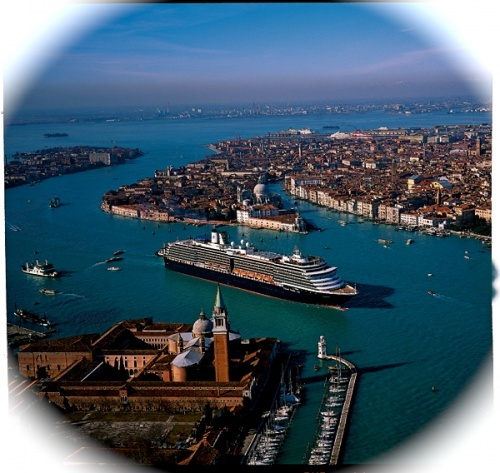
“The tragic accident ( Costa Concordia cruise ship wreck ) reinforces longstanding concern over the risk that large cruise liners pose to sites inscribed on UNESCO’s World Heritage List, particularly the Venice Lagoon and the Basin of San Marco,” wrote Francesco Bandarin, UNESCO’s Assistant Director-General for Culture, in a letter to the Italian Ministry of the Environment. (Above - Cruise Line regular stop in Venice)
UNESCO has called upon Italy to restrict maritime access to its most culturally and ecologically sensitive areas, including the lagoon city of Venice - renowned tourist destination and is visited by almost 300 large cruise ships each year. UNESCO urged the Italian Government to quickly develop alternative plans for seafaring traffic around the World Heritage site of Venice. The regular cruise liner traffic in Venice has contributed to damaging the fragile structure of the city, according to the agency. The massive ships cause water tides that erode the foundations of buildings and contribute to polluting the natural environment of the surrounding lagoon. See Film Report: “UNESCO New Heritage Sites” -
diplomaticallyincorrect.org/films/movie/new-world-heritage-sites/27579
On 13 January, the hull of the Italian cruise ship Costa Concordia was torn open after it ran aground off the coast of Tuscany’s Giglio Island. According to media reports, 15 people died and at least 18 are still missing. The ship was also carrying a reported 2,400 tonnes of fuel, prompting widespread concerns about a potential environmental disaster.
By Ambassador Muhamed Sacirbey
Facebook Become a Fan at “Diplomatically Incorrect”
Twitter – Follow at DiplomaticallyX
FOLLOW mo @MuhamedSacirbey
UNESCO Statement Below & Link to UNESCO -
www.unesco.org/new/en/unesco/
UNESCO calls for restrictions on cruise line traffic in Venice following Costa Concordia disaster
UNESCO has called on the Italian government to restrict access of large cruise ships to culturally and ecologically important areas, particularly Venice and its Lagoon which are visited by some 300 large cruise ships a year.
In a letter sent to the Italian Environment Minister on behalf of Director-General Irina Bokova, the Assistant Director-General for Culture Francesco Bandarin writes that “the tragic accident [of the Costa Concordia on 13 January] reinforces longstanding concern over the risk that large cruise liners pose to sites inscribed on UNESCO’s World Heritage List, particularly the Venice Lagoon and the Basin of San Marco.”
After presenting UNESCO’s condolences for the tragic loss of life caused by Costa Concordia accident and praising the efforts of the rescue teams and local population in dealing with the disaster, the letter urges the government to act quickly to develop alternative plans for maritime traffic around the World Heritage site of Venice.
The cruise liner traffic in Venice is particularly damaging because of the fragile structure of the city. The ships cause water tides that erode the foundations of buildings. They contribute to pollution and impact the cityscape as they dwarf monuments in the heart of the city.

